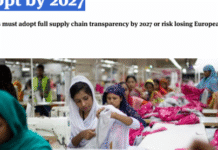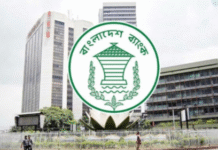
Finance minister AMA Muhith is seen with World Bank lead economist Sanjay Kathuria and country director (Bangladesh, Bhutan and Nepal) Qimiao Fan, Centre for Policy Dialogue distinguished fellow Mustafizur Rahman, Policy Research Institute chairman Zaidi Sattar, Bangladesh Enterprise Institute president Farooq Sobhan and PRAN-RFL Group chairman and chief executive officer Ahsan Khan Chowdhury holding the WB report titled ‘A Glass Half Full: The Promise of Regional Trade in South Asia’ at its launching ceremony, jointly organised by PRI and World Bank Group at the Amari Hotel in Dhaka on Wednesday. — New Age photo
Intra-South Asia annual trade could increase threefold to $67 billion from the existing $23 billion if trade barriers including tariffs, para tariffs and trust deficit are eliminated, said a World Bank report.
The report also estimated that Bangladesh had the potential to double its trade with South Asian countries to $18.9 billion from the existing $7.6 billion by eliminating the barriers.
The WB report titled ‘A Glass Half Full: The Promise of Regional Trade in South Asia’ was launched at a ceremony held at the Amari Hotel in Dhaka on Wednesday.
Policy Research Institute of Bangladesh and World Bank Group organised the report launching ceremony.
Bangladesh’s trade with the South Asian countries is 9 per cent of its total global trade, said World Bank lead economist Sanjay Kathuria while delivering presentation on the report.
The country’s trade with South Asian countries is $7.6 billion against $84.3 billion trade across the globe, he said.
The report mentioned India, Pakistan and Sri Lanka as the top three trading partners of Bangladesh in South Asia.
Speaking about the potential of regional trade, Sanjay said that South Asia was the most disjointed region despite being the most rapidly growing area.
‘The regional trade accounts for only 5 per cent of the total trade of this region with the global market,’ he said.
In South Asia, protection is greater in the case of imports from within the South Asian region than from the rest of the world, Sanjay observed.
He said even though the countries of the region reduced tariffs, several countries simultaneously introduced protectionist para tariffs, undermining tariff liberalisation.
He said that better regional connectivity would allow consumers to avail product at best prices along with providing them better life.
South Asia is in the bottom considering the intraregional trade as a share of regional gross domestic product compared with East Asia and Pacific, Latin America and the Caribbean, Middle East and North Africa, and Sub-Saharan Africa, he said.
Finance minister AMA Muhith said that the government was aware about the impact of border markets and about the importance of improving connectivity for increasing regional trade.
He said, ‘It seems to me that the country’s businessmen enjoy doing business with rest of the world rather than with the regional countries.’
Muhith also said an increased attention within this region to improve the trade climate would be very much useful for boosting trade.
Speaking about the connectivity barrier issue, the finance minister said that Bangladesh’s connectivity with the neighbouring countries had improved in recent times and they would work on the issue further.
World Bank country director (Bangladesh, Bhutan and Nepal) Qimiao Fan said that only 9 per cent of Bangladesh’s trade was with South Asian countries.
There are a lot of potentials to increase the trade and that’s why Bangladesh needs to rethink how to increase the potentials, he said.
Qimiao mentioned high tariff and para tariff, non-tariff, connectivity cost and border trust deficit as the four major barriers to increasing regional trade in South Asia.
Policy Research Institute chairman Zaidi Sattar said para tariffs had constrained the trade of this region.
‘It is the task of the policymakers to resolve the issue and move forward,’ he said.
‘Despite being most disjointed, South Asia has managed to attain the highest growth and it’s become a question how much growth potential we are missing for being disjointed,’ he said.
Centre for Policy Dialogue distinguished fellow Mustafizur Rahman said that six countries of this region would graduate from LDC status within a few years and the benefits that these counties had been enjoying in different regions including Europe as LDCs would go.
Considering the situation, these countries have to take initiatives for deepening of intra-region trade, he said.
Bangladesh Enterprise Institute president Farooq Sobhan said that there was a need for public diplomacy to create public awareness for increasing bilateral trade.
He also suggested improved capacity of customs authority along with better infrastructure and connectivity including rail, road and waterways.
Mentioning that PRAN attained above 30 per cent growth in India, PRAN-RFL Group chairman and chief executive officer Ahsan Khan Chowdhury said that better connectivity that would allow Bangladesh’s trucks to enter inside India would help them reduce cost of transportation significantly, which would benefit the consumers.
Source: New Age.









